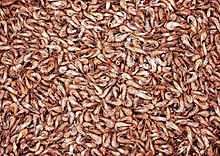Crangon crangon: Difference between revisions
ClueBot NG (talk | contribs) m Reverting possible vandalism by 81.82.199.112 to version by ChuispastonBot. False positive? Report it. Thanks, ClueBot NG. (991567) (Bot) |
No edit summary |
||
| Line 59: | Line 59: | ||
[[it:Crangon crangon]] |
[[it:Crangon crangon]] |
||
[[nl:Noordzeegarnaal]] |
[[nl:Noordzeegarnaal]] |
||
[[no:Sandreke]] |
|||
[[frr:Por]] |
[[frr:Por]] |
||
[[pcd:Soetréle]] |
[[pcd:Soetréle]] |
||
Revision as of 10:43, 25 April 2012
| Crangon crangon | |
|---|---|

| |
| Scientific classification | |
| Kingdom: | |
| Phylum: | |
| Subphylum: | |
| Class: | |
| Order: | |
| Infraorder: | |
| Family: | |
| Genus: | |
| Species: | C. crangon
|
| Binomial name | |
| Crangon crangon | |
| Synonyms [1] | |
| |
Crangon crangon is a commercially important species of shrimp fished mainly in the southern North Sea, although also found in the Irish Sea, Baltic Sea, Mediterranean Sea and Black Sea, as well as off much of Scandinavia and parts of Morocco's Atlantic coast.[1] Its common names include brown shrimp, common shrimp, bay shrimp, and sand shrimp, while translation of its French name crevette grise (or its Dutch equivalent grijze garnaal) sometimes leads to the English version grey shrimp.
Adults are typically 30–50 millimetres (1.2–2.0 in) long, although individuals up to 90 mm (3.5 in) have been recorded.[2] The animals have cryptic coloration, being a sandy brown colour, which can be changed to match the environment.[2] They live in shallow water, which can also be slightly brackish, and feed nocturnally.[2] During the day, they remain buried in the sand to escape predatory birds and fish, with only their antennae protruding.
Over 37,000 t of Crangon crangon were caught in 1999, with Germany and the Netherlands taking over 80% of this total.[1]
As food
The common shrimp is prized for is subtle flavour and its soft texture. One of the most famous culinary delights of France is the seafood platter, of which the shrimp plays a vital role. Brown shrimp are often prepared in the potted style in the UK. In Belgium, a typical dish is tomaat-garnaal: a tomato filled with shrimps in mayonnaise. In the coastal areas of Belgium, fresh unpeeled shrimp are often served as a snack accompanying beer (typically a sour ale).

References
- ^ a b c "Crangon crangon (Linnaeus, 1758)". Species Fact Sheets. Food and Agriculture Organization. Retrieved June 24, 2011.
- ^ a b c "Crangon crangon". ARKive. Retrieved June 24, 2011.
External links
 Media related to Crangon crangon at Wikimedia Commons
Media related to Crangon crangon at Wikimedia Commons- "Crangon crangon (Linnaeus, 1758)". Integrated Taxonomic Information System.
